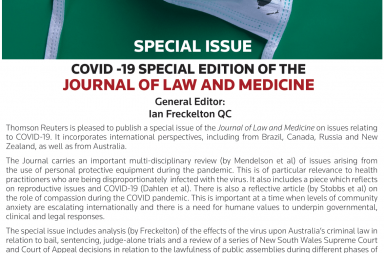*Please note that the links to the content in this Part will direct you to Westlaw AU.
The latest issue of The Tort Law Review (Volume 24 Part 2) contains the following material:
Articles
Vulnerability, tort and economic loss: Protection via contract – Meghan De Pinto-Smith
Vulnerability has emerged in Australia as a relevant consideration in determining the existence of a duty of care to avoid pure economic loss. However, opinions vary on what factors establish vulnerability. One question which has confounded the courts and legal commentators alike is whether a plaintiff’s capacity to protect himself or herself via contract, but failure to do so, should disentitle the plaintiff from being able to obtain relief for pure economic loss in tort on the basis that he or she was not vulnerable. This article considers the current state of authority on this question in Australia. It argues that a plaintiff’s capacity to contract for a warranty of protection should be irrelevant in assessing whether or not a plaintiff is vulnerable and that more broadly, the absence of vulnerability is not a valid reason for negating duty.
To purchase this article, complete the Individual Article Sale order form and email it to [email protected].
The uncertain scope of malicious prosecution: Insights from Canada – Michael Marin
In the last 15 years, courts throughout the Commonwealth have been struggling to redefine the scope of malicious prosecution. The vexing question is whether the cause of action may lie for wrongful administrative and civil proceedings, or whether it is restricted to criminal ones. This is exemplified by a number of divergent judgments in the United Kingdom and Australia, which are very difficult to reconcile on principled grounds. This article brings the Canadian experience on this issue to bear through an empirical analysis of cases from Ontario, which extended malicious prosecution to administrative proceedings 25 years ago, and thus offers a natural experiment of the implications of broadening the tort. This analysis shows that fears about opening the floodgates of litigation are unsubstantiated. Most claims in the sample did not make it to trial and three-quarters of them were dismissed. Furthermore, defendants usually prevailed on pre-trial motions to dismiss, which suggests that baseless claims may be disposed of quickly. Not surprisingly, the most common ground for dismissal was absence of malice, which indicates that the tort is sufficiently onerous to keep itself in check. In addition to this empirical analysis, the article examines both the early and more recent case law, concluding that defining the scope of the tort based on the nature of the underlying proceeding is unsupportable. Specifically, such a categorical approach produces inconsistent and arbitrary outcomes that have little to do with the tort’s policy rationale. Malicious prosecution also fills a real gap in the law because other torts do not apply, meaning that without it, victims of wrongful administrative or civil proceedings would be left uncompensated.
To purchase this article, complete the Individual Article Sale order form and email it to [email protected].
The price of a four-legged friend: Non-economic damage award in Australian pet litigation – Alexandra Whittaker and Megan Vine
It has been suggested that the continuing legal status of animals as property is at odds with our societal viewpoint of them, and fails to recognise the closeness of the human–animal bond. One area of law where this conflict manifests is in the provision of non-economic damages to pet owners, when a third party negligently causes their pet’s death or injury. Traditionally, the law has disallowed damage recovery in this scenario due to the animal’s proprietary legal status. However, judicial activism has occurred in some United States courts and recovery been permitted, resulting in the law being unclear and inconsistent. Australian sociological research demonstrates the depth of the public’s affection for their animals and it is likely to be only a matter of time before Australian courts are faced with similar non-economic damage claims in relation to pet harm. This article seeks to discover what lessons from the US experience can be applied, with adaptation, to the Australian context. The proposal is that Australia should avoid the judicial activist approach, since this encourages unlimited liability and inconsistency. Instead, reform should be proactive and occur through legislative intervention.
To purchase this article, complete the Individual Article Sale order form and email it to [email protected].
For the PDFÂ version of the table of contents, click here: Tort L Rev Vol 24 No 2 Contents.


